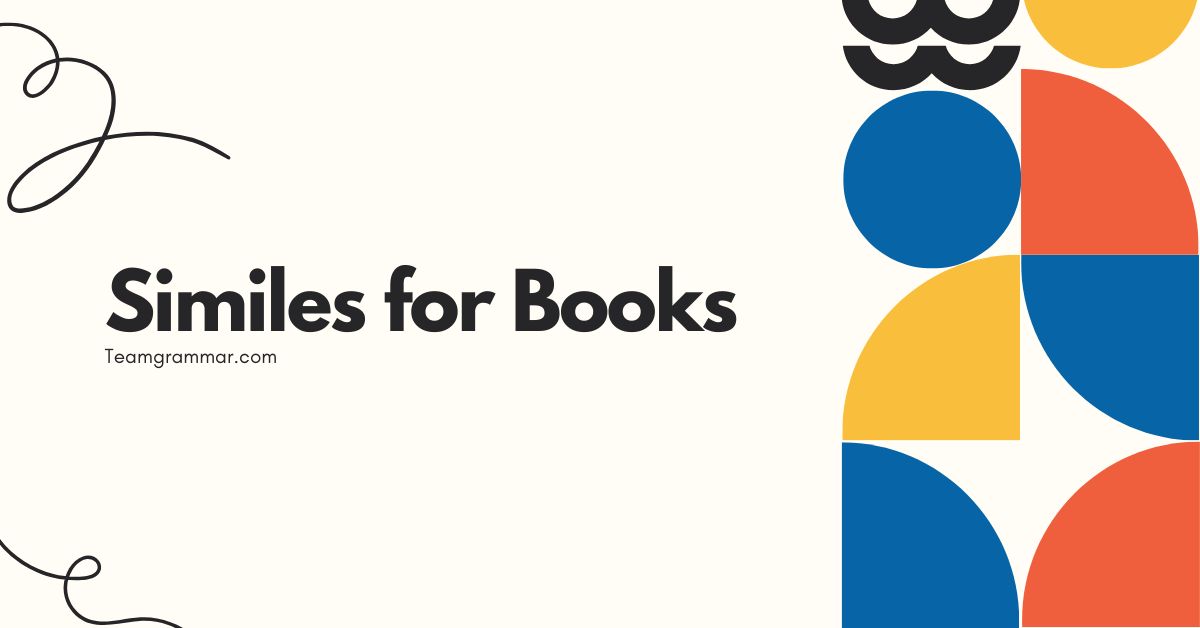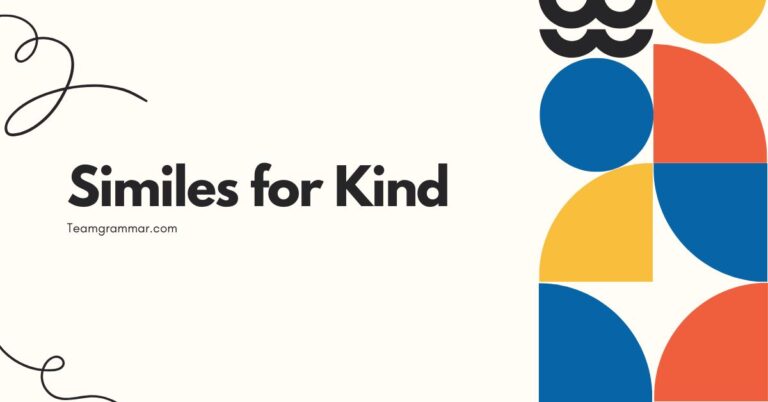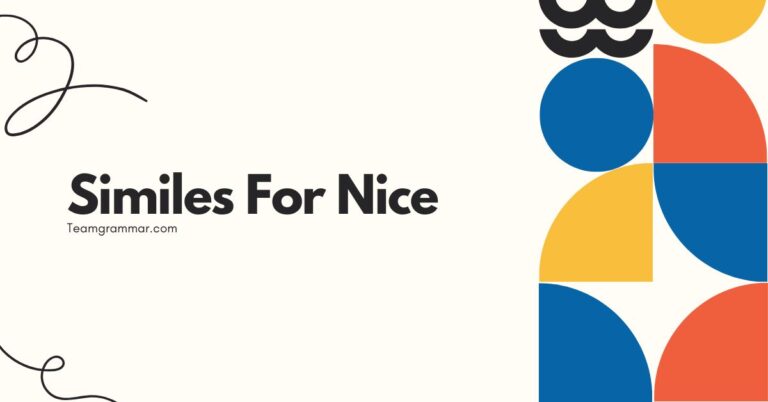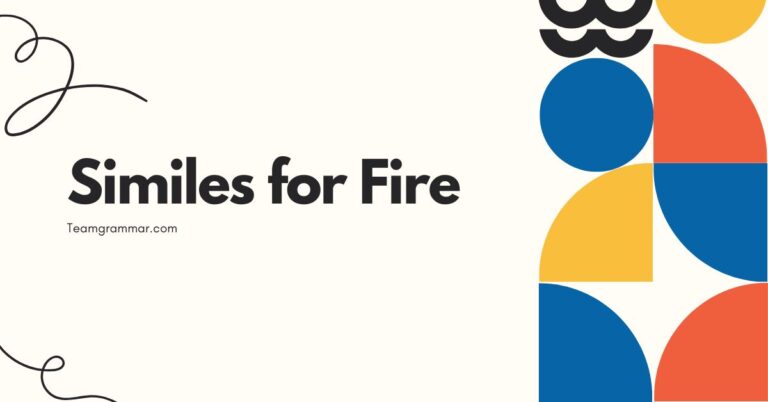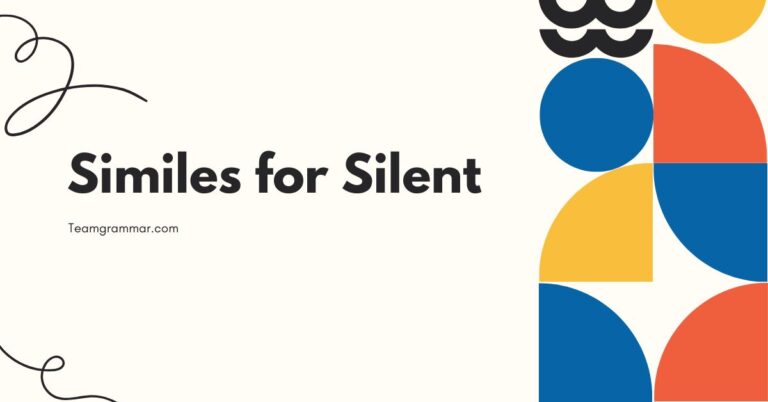33 Similes for Books: Enhancing Descriptions with Figurative Language
Similes are powerful tools that enrich descriptions and make writing more engaging. Understanding how to use similes effectively can significantly improve your ability to convey vivid imagery and connect with readers on a deeper level.
This article focuses on using similes specifically in the context of describing books, whether you’re writing a review, analyzing literature, or crafting your own stories. It will benefit students, writers, and anyone looking to enhance their understanding and use of figurative language.
Table of Contents
- Introduction
- Definition of Simile
- Structural Breakdown of a Simile
- Types of Similes
- Examples of Similes for Books
- Usage Rules for Similes
- Common Mistakes with Similes
- Practice Exercises
- Advanced Topics in Similes
- Frequently Asked Questions
- Conclusion
Introduction
Similes are essential tools in a writer’s arsenal, allowing for vivid descriptions and engaging comparisons. They bridge the gap between abstract concepts and concrete imagery, making complex ideas more accessible and relatable.
In the realm of literature, similes can breathe life into characters, settings, and themes, enriching the reading experience and leaving a lasting impression on the audience. Mastering the art of crafting effective similes is crucial for anyone seeking to improve their writing and analytical skills.
This article delves specifically into the use of similes when describing books. Whether you’re crafting a book review, analyzing a literary work, or writing your own fiction, understanding how to leverage similes can significantly enhance your descriptive power.
We’ll explore the definition of similes, their structural components, various types, and practical examples tailored to the world of books. Furthermore, we’ll cover common mistakes, usage rules, and advanced techniques to help you become a simile virtuoso.
By the end of this comprehensive guide, you’ll be equipped with the knowledge and skills to effectively use similes to describe books in a way that captivates your readers and elevates your writing to new heights. So, let’s embark on this literary journey and unlock the power of similes together.
Definition of Simile
Asimileis a figure of speech that directly compares two different things, highlighting their similarities. It uses words such as “like” or “as” to establish the connection.
Similes are used to make descriptions more vivid, engaging, and relatable by drawing parallels between the unfamiliar and the familiar. They are a fundamental tool in figurative language and are widely used in literature, poetry, and everyday speech.
Similes are classified as a type ofanalogy, which is a broader comparison between two things. However, similes are more direct and explicit, using “like” or “as” to signal the comparison.
The function of a simile is to enhance understanding and create a more sensory experience for the reader or listener. By comparing something to something else more familiar, the writer can evoke a stronger image or feeling.
Contextually, similes can be found in various forms of writing and speech. They are common in descriptive passages, where the author aims to paint a picture with words.
They are also used in persuasive writing to make an argument more compelling. In everyday conversation, similes can add color and expressiveness to casual communication.
Key Elements of a Simile
- Two Unlike Things: A simile always compares two things that are essentially different.
- Connecting Word: The words “like” or “as” are used to make the comparison explicit.
- Shared Characteristic: The comparison is based on a shared characteristic or quality between the two things.
Structural Breakdown of a Simile
Understanding the structure of a simile is essential for creating effective and impactful comparisons. A typical simile consists of three main components: thesubject, thelinking word(like or as), and theobject of comparison.
The subject is the thing being described, while the object of comparison is the thing it is being compared to. The linking word serves to connect the two and explicitly state the comparison.
The basic formula for a simile is: Subject + Linking Word + Object of Comparison. For example, in the simile “The book was as heavy as a brick,” the subject is “the book,” the linking word is “as,” and the object of comparison is “a brick.” This structure clearly and concisely draws a comparison between the weight of the book and the weight of a brick.
The order of these elements can sometimes be varied for stylistic effect, but the core components remain the same. For instance, you could say, “As heavy as a brick, the book was,” although this is less common.
The key is to ensure that the comparison is clear and easily understood.
Variations in Simile Structure
- Implied Similes: While less common, some similes may imply the “like” or “as” without explicitly stating it.
- Extended Similes: These involve a more detailed and elaborate comparison, often spanning multiple sentences.
- Negative Similes: These compare what something *is not* like, often using “not like” or “not as.”
Types of Similes
Similes can be categorized based on their function, the type of comparison they make, or their stylistic qualities. Understanding these different types can help you choose the most effective simile for your writing.
Descriptive Similes
These similes focus on providing a vivid description of the subject. They aim to create a clear and sensory image in the reader’s mind.
Explanatory Similes
These similes are used to clarify or explain something by comparing it to something more familiar. They aim to enhance understanding rather than just create a vivid image.
Humorous Similes
These similes are intended to be funny or amusing. They often involve unexpected or absurd comparisons.
Ironic Similes
These similes use irony to convey a meaning opposite to the literal comparison. They often highlight the absurdity of a situation.
Extended Similes
As mentioned earlier, extended similes involve a more detailed and elaborate comparison, often spanning multiple sentences. These allow for a deeper exploration of the similarities between the subject and the object of comparison.
Examples of Similes for Books
This section provides a comprehensive list of similes that can be used to describe various aspects of books, such as their plot, characters, writing style, and overall impact. These examples are categorized to help you find the most relevant simile for your specific needs.
Similes for Describing a Book’s Plot
The following table provides examples of similes used to describe the plot of a book. These similes capture the essence of the storyline, its pacing, and its overall complexity.
| Simile | Explanation |
|---|---|
| The plot unfolded like a delicate flower. | Suggests a gradual and beautiful unfolding of events. |
| The story moved as slow as molasses in January. | Implies a very slow and deliberate pace. |
| The plot twisted like a roller coaster. | Conveys unexpected turns and excitement. |
| The narrative was as predictable as sunrise. | Indicates a lack of originality or surprise. |
| The storyline was as tangled as a ball of yarn. | Suggests a complex and confusing plot. |
| The plot was as thin as paper. | Implies a lack of depth or substance. |
| The story progressed like a well-oiled machine. | Implies a smooth, efficient, and seamless progression of events. |
| The plot was as convoluted as a politician’s promise. | Suggests a complicated and potentially deceptive storyline. |
| The narrative flowed like a gentle stream. | Conveys a smooth and easy-to-follow story. |
| The plot thickened like a simmering stew. | Implies increasing complexity and suspense. |
| The story was as gripping as a thriller. | Indicates a captivating and suspenseful narrative. |
| The plot was as predictable as a fairy tale. | Suggests a familiar and unoriginal storyline. |
| The narrative jumped around like a frog in a pond. | Conveys a disjointed and erratic plot. |
| The story was as captivating as a campfire tale. | Implies an engaging and enthralling narrative. |
| The plot was as intricate as a spiderweb. | Suggests a complex and interconnected storyline. |
| The narrative was as straightforward as a highway. | Indicates a simple and direct plot. |
| The story was as refreshing as a cool breeze. | Implies a novel and pleasant narrative. |
| The plot was as dense as a forest. | Suggests a complex and layered storyline. |
| The narrative was as meandering as a river. | Conveys a winding and indirect plot. |
| The story was as explosive as a volcano. | Implies a dramatic and impactful narrative. |
| The plot was as circular as a ring. | Suggests a narrative that returns to its starting point. |
| The narrative was as fragmented as broken glass. | Conveys a disjointed and incomplete storyline. |
| The story was as relentless as a storm. | Implies a narrative that is intense and unyielding. |
Similes for Describing a Book’s Characters
The following table provides examples of similes used to describe the characters in a book. These similes capture their personalities, traits, and roles within the story.
| Simile | Explanation |
|---|---|
| The protagonist was as brave as a lion. | Implies courage and strength. |
| The villain was as cunning as a fox. | Suggests slyness and trickery. |
| The character was as innocent as a lamb. | Conveys purity and naivety. |
| The hero was as flawed as any human. | Indicates realism and relatability. |
| The protagonist was as resilient as bamboo. | Suggests an ability to recover quickly from difficulties. |
| The character was as mysterious as the night. | Implies an enigmatic and intriguing personality. |
| The protagonist was as stubborn as a mule. | Indicates an unyielding and obstinate nature. |
| The character was as wise as an owl. | Suggests intelligence and insight. |
| The protagonist was as gentle as a breeze. | Conveys kindness and tenderness. |
| The character was as cold as ice. | Implies a lack of emotion or empathy. |
| The protagonist was as strong as an ox. | Indicates great physical strength and endurance. |
| The character was as charming as a prince. | Suggests charisma and attractiveness. |
| The protagonist was as vulnerable as a child. | Conveys fragility and susceptibility to harm. |
| The character was as complex as a puzzle. | Implies a multifaceted and difficult-to-understand personality. |
| The protagonist was as determined as a marathon runner. | Indicates unwavering resolve and perseverance. |
| The character was as lost as a ship at sea. | Suggests confusion and a lack of direction. |
| The protagonist was as radiant as the sun. | Conveys warmth, positivity, and energy. |
| The character was as broken as a shattered vase. | Implies emotional damage and vulnerability. |
| The protagonist was as adaptable as a chameleon. | Indicates an ability to adjust to changing circumstances. |
| The character was as relentless as time. | Suggests an unyielding and unstoppable force. |
| The protagonist was as captivating as a siren. | Implies an alluring and irresistible charm. |
| The character was as unpredictable as the weather. | Conveys erratic and inconsistent behavior. |
| The protagonist was as grounded as an oak tree. | Indicates stability, strength, and resilience. |
Similes for Describing a Book’s Writing Style
The following table provides examples of similes used to describe the writing style of a book. These similes capture the tone, voice, and overall quality of the writing.
| Simile | Explanation |
|---|---|
| The writing style was as elegant as a swan. | Suggests grace and sophistication. |
| The prose was as sharp as a razor. | Implies precision and clarity. |
| The narrative voice was as warm as a fireplace. | Conveys comfort and intimacy. |
| The writing was as dry as the desert. | Indicates a lack of emotion or engagement. |
| The prose flowed as smoothly as silk. | Suggests an easy and effortless reading experience. |
| The writing was as vibrant as a painting. | Implies rich imagery and colorful descriptions. |
| The narrative voice was as distant as a star. | Conveys detachment and objectivity. |
| The writing was as dense as a textbook. | Indicates complexity and difficulty. |
| The prose was as lyrical as a song. | Suggests musicality and emotional depth. |
| The writing was as raw as an open wound. | Implies honesty and vulnerability. |
| The narrative voice was as comforting as a lullaby. | Conveys reassurance and peace. |
| The writing was as repetitive as a broken record. | Indicates monotony and lack of originality. |
| The prose was as intricate as lacework. | Suggests complexity and attention to detail. |
| The writing was as clear as a mountain stream. | Implies simplicity and transparency. |
| The narrative voice was as authoritative as a professor. | Conveys knowledge and expertise. |
| The writing was as rambling as a country road. | Indicates a lack of focus and direction. |
| The prose was as evocative as a memory. | Suggests the ability to stir emotions and create vivid images. |
| The writing was as clumsy as a newborn foal. | Implies awkwardness and lack of skill. |
| The narrative voice was as playful as a child. | Conveys innocence and lightheartedness. |
| The writing was as haunting as a ghost story. | Suggests a lingering and unsettling effect. |
| The prose was as rhythmic as a heartbeat. | Implies a steady and engaging flow. |
| The writing was as pretentious as a snob. | Indicates artificiality and a desire to impress. |
| The narrative voice was as authentic as a diary entry. | Conveys sincerity and genuineness. |
Similes for Describing a Book’s Overall Impact
The following table provides examples of similes used to describe the overall impact of a book. These similes capture the emotional, intellectual, and lasting effects of reading the book.
| Simile | Explanation |
|---|---|
| Reading the book was like taking a journey to another world. | Suggests an immersive and transformative experience. |
| The book stayed with me like a haunting melody. | Implies a lasting and memorable impact. |
| Reading the book was as comforting as a warm embrace. | Conveys a sense of solace and reassurance. |
| The book left me feeling as empty as a hollow shell. | Indicates a profound sense of loss or sadness. |
| Reading the book was like climbing a mountain. | Suggests a challenging but rewarding experience. |
| The book opened my eyes like a sudden revelation. | Implies a transformative and enlightening experience. |
| Reading the book was as exhilarating as a roller coaster ride. | Conveys excitement and thrill. |
| The book left me feeling as inspired as a muse. | Indicates motivation and creativity. |
| Reading the book was like drinking a cup of hot chocolate on a cold day. | Suggests comfort and warmth. |
| The book left me feeling as lost as a maze. | Implies confusion and disorientation. |
| Reading the book was like watching a beautiful sunset. | Conveys peace and tranquility. |
| The book left me feeling as empowered as a superhero. | Indicates strength and capability. |
| Reading the book was like having a conversation with a wise friend. | Suggests insight and understanding. |
| The book left me feeling as heartbroken as a betrayed lover. | Implies deep sorrow and disappointment. |
| Reading the book was like exploring a hidden treasure. | Conveys discovery and excitement. |
| The book left me feeling as thoughtful as a philosopher. | Indicates contemplation and reflection. |
| Reading the book was like attending a grand ball. | Suggests elegance and sophistication. |
| The book left me feeling as empty as a deflated balloon. | Implies disappointment and anticlimax. |
| Reading the book was like solving a complex puzzle. | Conveys intellectual stimulation and satisfaction. |
| The book left me feeling as transformed as a butterfly. | Indicates significant personal growth and change. |
Usage Rules for Similes
Using similes effectively requires adherence to certain rules and guidelines. These rules ensure that the comparison is clear, relevant, and impactful.
Clarity
The comparison should be easily understood by the reader. Avoid obscure or overly complex references that may confuse the audience.
Relevance
The comparison should be relevant to the subject being described. The shared characteristic between the two things being compared should be meaningful and appropriate.
Originality
While familiar similes can be effective, strive for originality to make your writing more engaging and memorable. Avoid clichés and overused comparisons.
Consistency
Ensure that the simile is consistent with the overall tone and style of your writing. Avoid jarring or inappropriate comparisons that may disrupt the flow of the narrative.
Avoiding Mixed Metaphors and Similes
A common error is mixing metaphors or similes, which can create confusing or nonsensical imagery. For example, avoid phrases like “The plot was as tangled as a ball of yarn, sailing smoothly on the ocean,” as it combines unrelated images.
Common Mistakes with Similes
Even experienced writers can make mistakes when using similes. Here are some common errors to avoid:
Using Cliches
Cliches are overused similes that have lost their impact. Examples include “as blind as a bat” or “as quiet as a mouse.” Avoid these and strive for more original comparisons.
Making Illogical Comparisons
Ensure that the comparison makes sense and is based on a shared characteristic. Avoid comparing things that have no logical connection.
Overusing Similes
While similes can enhance your writing, using too many can make it feel cluttered and distracting. Use similes sparingly and only when they add significant value.
Using Incorrect Linking Words
Remember to use “like” or “as” to make the comparison explicit. Avoid using other words that may weaken or confuse the simile.
Correct: The book was as heavy as a brick.
Incorrect: The book was heavy to a brick.
Practice Exercises
Test your understanding of similes with these practice exercises. Fill in the blanks with appropriate similes to complete the sentences.
| Question | Answer |
|---|---|
| 1. The protagonist’s determination was __________. | as unwavering as a mountain. |
| 2. The villain’s heart was __________. | as cold as ice. |
| 3. The plot of the book was __________. | as intricate as a spiderweb. |
| 4. The writing style was __________. | as elegant as a swan. |
| 5. Reading the book was __________. | like taking a journey to another world. |
| 6. The character’s wisdom was __________. | as profound as an ancient sage. |
| 7. The story’s ending was __________. | as shocking as a sudden thunderclap. |
| 8. The author’s descriptions were __________. | as vivid as a painter’s canvas. |
| 9. The book’s impact was __________. | as lasting as a cherished memory. |
| 10. The narrative’s pace was __________. | as slow as molasses in January. |
More Practice: Rewrite the following sentences using similes to make them more descriptive.
| Original Sentence | Rewritten Sentence with Simile |
|---|---|
| 1. The book was very long. | The book was as long as a never-ending road. |
| 2. The character was brave. | The character was as brave as a lion. |
| 3. The writing was beautiful. | The writing was as beautiful as a blooming garden. |
| 4. The story was complex. | The story was as complex as a labyrinth. |
| 5. The ending was surprising. | The ending was as surprising as a bolt from the blue. |
| 6. The villain was evil. | The villain was as evil as a serpent in the grass. |
| 7. The hero was strong. | The hero was as strong as an oak tree. |
| 8. The plot was interesting. | The plot was as interesting as a hidden treasure map. |
| 9. The setting was magical. | The setting was as magical as a dream. |
| 10. The characters were realistic. | The characters were as realistic as people you meet every day. |
Advanced Topics in Similes
For advanced learners, exploring more complex aspects of similes can further enhance their writing skills.
Subverting Expectations
Challenge conventional comparisons by creating similes that subvert reader expectations. This can add humor, irony, or a unique perspective to your writing.
Using Cultural References
Incorporate cultural references into your similes to add depth and resonance. However, be mindful of your audience and ensure that the references are easily understood.
Creating Extended, Unique Similes
Don’t be afraid to create your own similes. The more unique and tailored your similes are, the more your writing will stand out.
Practice crafting similes that reflect your personal style and perspective.
For example, instead of saying “The book was as interesting as a good movie,” you could say “The book was as captivating as watching a time-lapse of a flower blooming, revealing new layers of beauty with each passing moment.”
Frequently Asked Questions
- What is the difference between a simile and a metaphor?
A simile directly compares two things using “like” or “as,” while a metaphor implies a comparison without using these words. A simile says something is like something else; a metaphor says something is something else.
- Can a simile be a cliché?
Yes, if it is overused and lacks originality. Strive to create fresh and unique comparisons to avoid clichés.
- How can I make my similes more creative?
Think outside the box and consider unexpected comparisons. Focus on specific details and sensory imagery to create vivid and memorable similes. Draw inspiration from your own experiences and observations.
- Is it okay to use similes in formal writing?
Yes, but use them judiciously. Similes can add color and engagement to formal writing, but avoid overusing them or using overly casual comparisons.
- How do I know if a simile is effective?
An effective simile enhances understanding, creates a vivid image, and adds value to your writing. If the comparison is confusing or irrelevant, it is not effective.
- What are some common simile mistakes to avoid?
Avoid cliches, illogical comparisons, overusing similes, and using incorrect linking words.
- Can a simile be negative?
Yes, a simile can compare what something is not like. For example, “The book was not as exciting as I had hoped.”
- How can I practice using similes?
Practice by rewriting sentences using similes, creating similes to describe everyday objects, and analyzing similes in literature. The more you practice, the better you will become at crafting effective similes.
- Should I always use similes when describing books?
No, similes are a tool to enhance description, but not a necessity. Use them when they add value and create a stronger impact, but don’t force them into your writing.
- How do I choose the right object of comparison for my simile?
Choose an object of comparison that shares a relevant characteristic with the subject and is familiar to your audience. Consider the emotional and sensory associations of the object to create the desired effect.
- Can a simile be used to describe abstract concepts?
Yes, similes can be particularly effective for describing abstract concepts by comparing them to something more concrete and tangible. This can make complex ideas more accessible and relatable.
Conclusion
Mastering the art of using similes is a valuable skill for any writer or reader. By understanding the definition, structure, types, and usage rules of similes, you can significantly enhance your ability to describe books in a vivid and engaging way.
Remember to avoid common mistakes, practice regularly, and strive for originality in your comparisons.
Similes are more than just decorative flourishes; they are powerful tools that can deepen understanding, evoke emotions, and create lasting impressions. By incorporating similes thoughtfully and effectively into your writing, you can elevate your descriptions and connect with your audience on a deeper level.
So, embrace the power of similes and let your words paint a thousand pictures.
Continue to explore and experiment with similes in your writing and analysis. Pay attention to how other authors use similes and learn from their techniques.
With practice and dedication, you can become a simile virtuoso and unlock the full potential of this versatile figure of speech. Happy writing!

